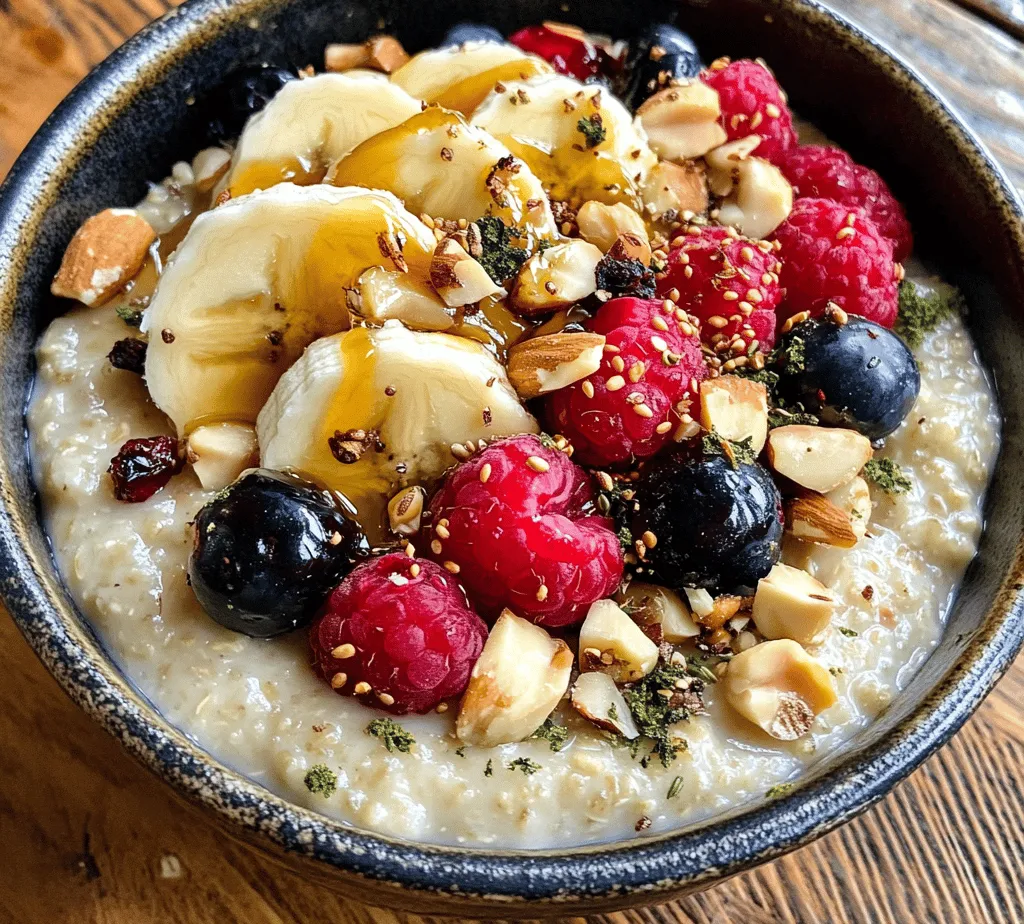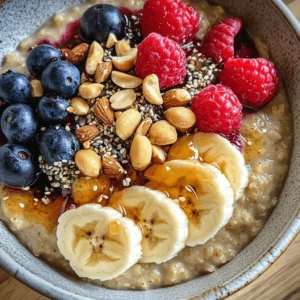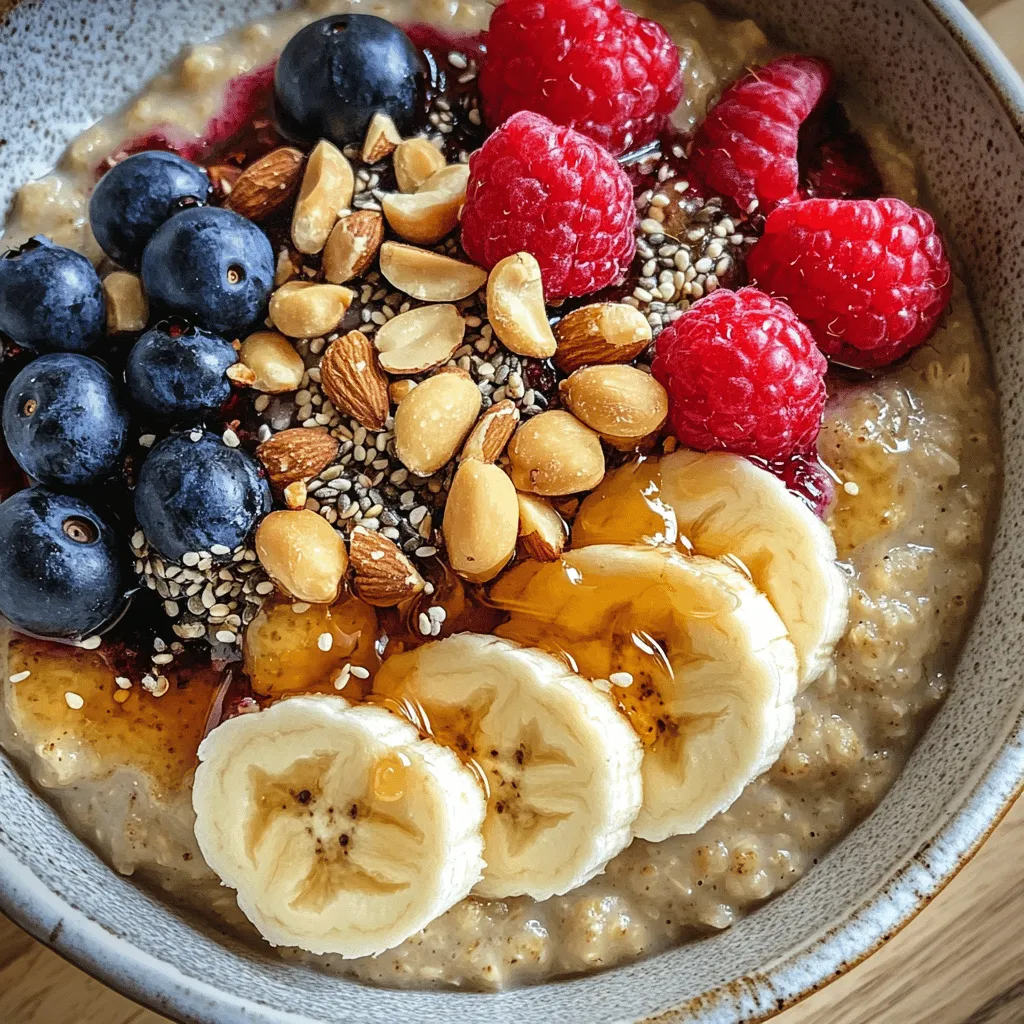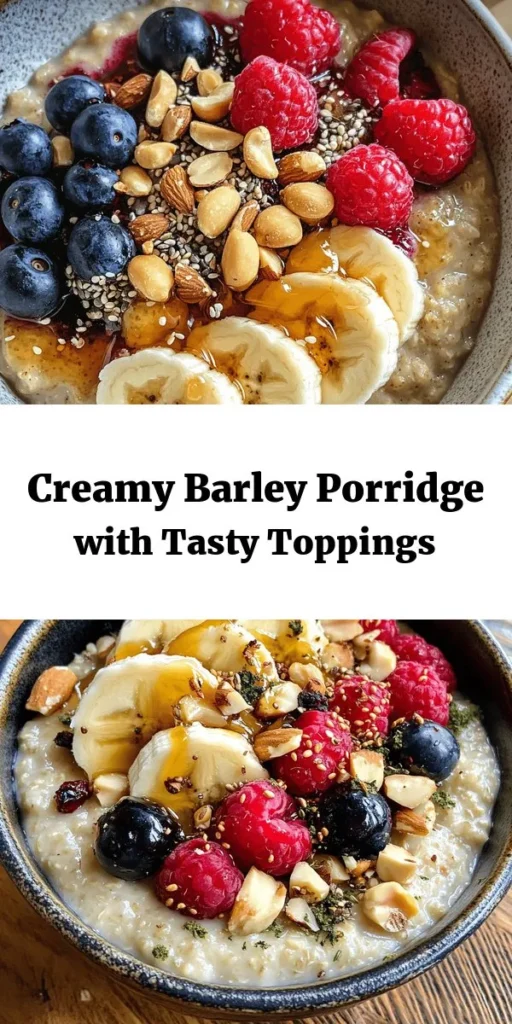When it comes to breakfast, many of us lean towards quick options that often sacrifice nutrition for convenience. However, there’s a gem in the world of grains that has been nourishing people for centuries—barley. This humble grain is not just versatile; it is a nutritional powerhouse that can elevate your morning routine with its rich texture and flavor. In this article, we will explore the Creamy Barley Porridge Delight, a dish that not only satisfies your hunger but also provides a wealth of health benefits.
Exploring the Versatility of Barley in Breakfast
Barley is one of the oldest cultivated grains, dating back thousands of years. Its use in various cuisines around the world is a testament to its adaptability. While traditionally associated with soups and stews, barley is making a significant comeback as a breakfast staple—especially in the form of porridge. Creamy Barley Porridge Delight takes this ancient grain and transforms it into a warm, comforting bowl of goodness that can be customized to suit any palate.
The beauty of barley lies in its ability to absorb flavors while maintaining a delightful chewiness, making it an ideal base for a variety of toppings and mix-ins. Whether you prefer it sweet or savory, barley can adapt to your morning cravings. From adding fresh fruits and nuts to drizzling with honey or maple syrup, the possibilities are endless.
Why Barley is a Nutritional Powerhouse
Barley is not only versatile but also packed with nutrition. It is an excellent source of dietary fiber, which is essential for digestive health. Fiber aids in maintaining a healthy gut flora and can help prevent constipation. Additionally, barley has a low glycemic index, which means it releases energy slowly, keeping you fuller for longer and helping maintain stable blood sugar levels.
In a world where we often reach for processed grains, barley stands out as a wholesome alternative. It is rich in essential vitamins and minerals, including B vitamins, iron, magnesium, and selenium. These nutrients contribute to overall health, supporting everything from energy production to immune function.
The Comfort of Warm Porridge in Your Morning Routine
There’s something inherently comforting about a warm bowl of porridge on a chilly morning. Creamy Barley Porridge Delight offers not just sustenance but also a sense of indulgence that can make even the most rushed mornings feel special. The creamy texture, coupled with the warm flavors of cinnamon and vanilla, creates a delightful experience that is both nourishing and satisfying.
Incorporating barley porridge into your breakfast routine can serve as a gentle reminder to slow down and appreciate the moment. As you prepare this dish, you will find that the act of cooking becomes a meditative practice, allowing you to start your day on a positive note.
Understanding Barley: A Nutritional Overview
Before diving into the specifics of preparing Creamy Barley Porridge Delight, it’s essential to understand the nutritional profile of barley, particularly pearl barley, which is commonly used in porridge recipes.
Nutritional Benefits of Pearl Barley
Pearl barley is the most processed form of barley, with the outer hull removed and polished to achieve a smooth surface. This makes it more tender and quicker to cook than hulled barley, while still retaining a significant amount of its nutritional benefits. A typical serving of cooked pearl barley (about 1 cup) contains approximately:
– Calories: 193
– Carbohydrates: 44 g
– Protein: 3.5 g
– Fat: 0.5 g
– Fiber: 6 g
This impressive fiber content makes pearl barley an excellent choice for those looking to increase their fiber intake and enhance digestive health.
High Fiber Content and Digestive Health
One of the standout features of barley is its high fiber content, with both soluble and insoluble fibers present. Soluble fiber helps to regulate blood sugar levels and can lower cholesterol, while insoluble fiber aids in digestion and promotes regular bowel movements. This combination makes barley an ideal food for maintaining digestive health and preventing issues such as constipation.
Rich in Essential Vitamins and Minerals
In addition to fiber, barley is a rich source of essential vitamins and minerals. It contains B vitamins, which play a crucial role in energy metabolism, as well as minerals like iron, which is vital for oxygen transport in the blood. The presence of magnesium supports muscle and nerve function, while selenium acts as an antioxidant, protecting the body from oxidative stress.
Low Glycemic Index and Its Benefits
Barley has a low glycemic index (GI), which means that it causes a gradual rise in blood sugar levels rather than a quick spike. This characteristic is particularly beneficial for individuals with diabetes or those looking to manage their weight. The slow-digesting carbohydrates in barley provide sustained energy, making it a perfect choice for breakfast.
Comparison with Other Grains
When comparing barley to other popular grains like oats and rice, it becomes clear that barley holds its own in terms of nutrition. While oats are often praised for their health benefits, barley offers a similar fiber content but with a unique texture and flavor. Notably, barley contains more dietary fiber than oats, making it a superior option for those focusing on digestive health.
Barley vs. Oats: Which is Healthier?
While both barley and oats are nutritious, the choice between them ultimately depends on individual dietary needs. Barley is a great source of fiber, antioxidants, and essential nutrients, while oats are higher in protein. Each grain has its unique benefits, and incorporating both into your diet can provide a wide range of nutrients.
The Unique Qualities of Barley in Cooking
In addition to its nutritional benefits, barley offers unique qualities in cooking. Its chewy texture and nutty flavor make it a delightful addition to various dishes, from soups to salads. When cooked as porridge, barley absorbs flavors beautifully, making it a versatile base for both sweet and savory toppings.
Ingredients Breakdown for Creamy Barley Porridge Delight
To create the perfect Creamy Barley Porridge Delight, we need to gather a few essential ingredients. Each component plays a vital role in crafting a delicious and nutritious breakfast.
Key Ingredients and Their Roles
– Pearl Barley: The star ingredient of this dish, pearl barley provides a chewy texture and nutty flavor while delivering numerous health benefits.
– Water or Vegetable Broth: The cooking liquid can significantly influence the flavor profile. While water is the most basic option, using vegetable broth adds depth and richness to the porridge.
– Milk Choices: The addition of milk (dairy or plant-based) creates a creamy consistency, enhancing the overall richness of the dish.
– Sweeteners: Natural sweeteners such as honey or maple syrup can be added to enhance the flavor without overwhelming the dish.
– Spices and Flavorings: A dash of cinnamon and a splash of vanilla extract can elevate the taste, adding warmth and aromatic notes to the porridge.
– Optional Toppings: This is where you can get creative! Fresh or dried fruits, nuts, and seeds can be added to enhance both flavor and nutrition.
Pearl Barley: The Star of the Dish
As mentioned, pearl barley is the main ingredient in this recipe. Its ability to absorb flavors while providing a chewy texture makes it a perfect choice for porridge. When cooked, pearl barley becomes tender yet retains a slight bite, resulting in a satisfying breakfast experience.
Water vs. Vegetable Broth: Flavor Enhancements
When preparing barley porridge, the choice of cooking liquid can alter the flavor dramatically. Using plain water will yield a mild taste, but for a more flavorful porridge, consider using vegetable broth. The broth infuses the barley with additional flavor, creating a more robust and savory base for your dish.
Milk Choices: Dairy vs. Plant-Based Options
The addition of milk is crucial for achieving that creamy consistency in the porridge. You can use any type of milk—whole, skim, almond, oat, or coconut—depending on personal preference and dietary needs. Each option imparts its unique flavor profile, so feel free to experiment and find the combination that works best for you.
Sweeteners: Honey or Maple Syrup for Natural Sweetness
To complement the nutty flavor of barley, a touch of sweetness can go a long way. Honey and maple syrup are both excellent natural sweeteners that can be drizzled over the finished porridge. They not only add flavor but also provide additional health benefits, such as antioxidants and vitamins.
Spices and Flavorings: The Role of Cinnamon and Vanilla
A sprinkle of cinnamon can transform your barley porridge, offering warmth and depth of flavor. Additionally, a splash of vanilla extract enhances the overall sweetness and aroma, making each bite feel indulgent.
Optional Toppings: Enhancing Flavor and Nutrition
To make your Creamy Barley Porridge Delight truly your own, consider adding various toppings. Fresh fruits like berries, bananas, or apples can provide a burst of natural sweetness and vitamins. Dried fruits, such as raisins or cranberries, offer chewiness and additional flavor. Furthermore, nuts and seeds contribute healthy fats, protein, and crunch, rounding out the nutritional profile of your breakfast.
Fresh vs. Dried Fruits: Nutritional Benefits
Both fresh and dried fruits bring unique benefits to your porridge. Fresh fruits retain most of their vitamins and hydration, while dried fruits are more concentrated in sugars and nutrients, providing a quick energy boost. The choice between the two depends on your taste preferences and nutritional goals.
The Importance of Nuts and Seeds in Your Diet
Incorporating nuts and seeds into your breakfast not only enhances flavor but also adds essential nutrients. Nuts like almonds, walnuts, or pecans provide healthy fats, protein, and fiber, while seeds such as chia or flaxseeds offer omega-3 fatty acids and additional fiber. Together, they contribute to a balanced and fulfilling meal.
Step-by-Step Cooking Instructions
With the ingredients gathered, we can now dive into the cooking process for Creamy Barley Porridge Delight. The preparation is straightforward, ensuring that even novice cooks can create this wholesome breakfast with ease.
Preparing the Barley: Ensuring Clean and Ready Grains
Before cooking, it’s important to prepare the barley properly. Start by measuring out the desired amount of pearl barley, typically about 1 cup for four servings. Place the barley in a fine-mesh sieve or a bowl and rinse it thoroughly under running water. This step removes any dust or debris and helps to enhance the grain’s natural flavor.
The Importance of Rinsing Barley
Rinsing barley is essential for achieving the best flavor and texture in your porridge. This simple step not only cleans the grains but also helps to remove excess starch, which can lead to clumping during cooking. By rinsing, you ensure that each grain cooks evenly and maintains that delightful chewiness that makes barley porridge so satisfying.
—
This detailed introduction and breakdown of the recipe will guide readers through the nutritional benefits of barley and the preparation needed to create a delicious Creamy Barley Porridge Delight. Stay tuned for the next part, where we will delve into the step-by-step cooking instructions to bring this wholesome breakfast to life.

Cooking the Barley: Achieving the Perfect Texture
To create a delightful creamy barley porridge, the first step is cooking the barley to achieve the perfect texture. Barley can vary in cooking time depending on the type you choose: hulless, pearl, or quick-cooking barley. For this recipe, pearl barley is a popular choice due to its tender texture and ability to absorb flavors.
1. Rinse the Barley: Start by rinsing the barley under cool running water to remove any debris or excess starch. This step ensures that your porridge will have a clean flavor and prevents it from becoming overly sticky.
2. Soak the Barley (Optional): For optimal texture and to reduce cooking time, consider soaking the barley in water for at least 2 hours or overnight. This will soften the grains and allow for a creamier porridge.
3. Cooking the Barley: In a medium saucepan, combine 1 cup of rinsed (and optionally soaked) barley with 3 cups of water or broth. Bring the mixture to a boil over medium heat. Once boiling, reduce the heat to low, cover, and let it simmer. Pearl barley typically takes about 30 to 40 minutes to cook until tender but still slightly chewy.
Tips for Simmering Barley: Time and Temperature
Achieving the right texture requires careful attention during cooking. Here are some valuable tips for simmering barley effectively:
– Maintain a Low Simmer: After bringing the water to a boil, it’s essential to reduce the heat to low. A gentle simmer will allow the barley to cook evenly without becoming mushy.
– Stir Occasionally: Stirring the barley every 10 minutes helps to prevent it from settling at the bottom of the pot and sticking. It also ensures that the grains cook uniformly.
– Check for Doneness: Taste the barley around the 30-minute mark. It should be tender but still have a slight bite. If it’s not quite there, continue simmering and check every five minutes.
Creating the Creamy Mixture: Incorporating Milk and Flavors
Once the barley is cooked to your liking, it’s time to transform it into a creamy delight. This is where the magic happens, as you incorporate milk and additional flavors.
1. Add Milk: For a creamy consistency, slowly stir in 1 to 2 cups of your choice of milk—dairy or non-dairy like almond, coconut, or oat milk—into the cooked barley. Adjust the quantity based on your desired creaminess.
2. Sweeten and Flavor: To enhance the taste of your porridge, add sweeteners such as honey, maple syrup, or agave nectar to your liking. Consider incorporating spices like cinnamon, nutmeg, or vanilla extract for added depth. Start with 1 teaspoon of cinnamon and adjust according to your preference.
3. Heat Through: Continue to cook the mixture over low heat, stirring occasionally until heated through and the flavors meld together beautifully. This should take about 5 to 10 minutes.
How to Adjust Consistency for Desired Creaminess
The beauty of creamy barley porridge lies in its versatility. If you find the porridge too thick, simply add more milk or water until it reaches your desired consistency. Conversely, if it’s too thin, you can cook it a bit longer on low heat to allow some of the liquid to evaporate, thickening the porridge. Taste and adjust the seasonings accordingly before serving.
Serving Suggestions: Presentation Matters
Presentation can elevate the dining experience, even for a humble bowl of porridge. Here are some serving suggestions to make your creamy barley porridge visually appealing:
– Choose the Right Bowl: Opt for a deep bowl that allows for generous servings. A contrasting color to the porridge can make it pop.
– Layering: Pour the creamy barley porridge into your bowl, and if desired, create layers by adding fruits or nuts on top.
– Garnishing: Fresh herbs, edible flowers, or a sprinkle of seeds can add a burst of color and flair to your dish.
Ideas for Beautifully Topped Porridge
Toppings can take your creamy barley porridge from simple to extraordinary. Here are a few topping ideas:
– Fresh Fruits: Add slices of banana, berries, or diced apples for a touch of sweetness and freshness. Consider caramelizing the apple slices for an added depth of flavor.
– Nuts and Seeds: Sprinkle chopped nuts like almonds, walnuts, or pecans, along with seeds such as chia or flax for added crunch and nutrition.
– Yogurt or Cream: A dollop of Greek yogurt or coconut cream adds richness and creaminess, enhancing the overall texture.
– Cacao or Coconut Flakes: For a decadent twist, sprinkle some cocoa nibs or toasted coconut flakes on top for an indulgent finish.
Cultural Variations of Barley Porridge
Barley is a global grain, and its versatility is reflected in various cultural breakfast dishes. Here are some perspectives on barley porridge from around the world:
Global Perspectives on Barley in Breakfast Dishes
Barley has been a staple grain in many cultures, often incorporated into breakfast foods for its nutritional benefits. In parts of Europe, barley porridge is a traditional breakfast dish known for its heartiness and sustenance.
Exploring Traditional Barley Porridge Recipes from Different Cultures
– Scotland: In Scotland, barley is often used to make “gruel,” a simple porridge that can be flavored with honey or fruit.
– Russia: Russian barley porridge, known as “perlovka,” is typically served with milk and butter, providing a comforting start to the day.
– East Asia: Some East Asian cultures incorporate barley into their congee, a rice porridge variant, offering a unique texture and flavor profile.
How Barley is Used in Various Culinary Traditions
Beyond breakfast, barley finds its way into numerous dishes worldwide, from soups and salads to stews and baked goods. Its adaptability and nutritional profile make it a favored ingredient for many culinary traditions.
Health Benefits of Incorporating Barley into Your Diet
In addition to its delightful taste, barley is packed with health benefits that make it a worthy addition to your diet.
Understanding Whole Grains and Their Impact on Health
Barley is a whole grain, meaning it retains its bran, germ, and endosperm, providing a wealth of nutrients. Whole grains are renowned for their health benefits, including improved digestion and reduced risk of chronic diseases.
The Role of Barley in Weight Management
Rich in fiber, barley can help curb hunger and promote feelings of fullness. Incorporating barley into your meals can be an effective strategy for weight management, as it helps regulate appetite and reduces caloric intake.
Heart Health and Cholesterol Control through Barley Consumption
Barley is particularly beneficial for heart health. The soluble fiber found in barley can help lower cholesterol levels, reducing the risk of heart disease. Regular consumption of barley can contribute to improved cardiovascular health.
Barley as a Versatile Ingredient for Different Dietary Needs
Barley is suitable for a range of dietary preferences, including vegetarian and vegan diets. Its nutrient density makes it an excellent choice for anyone looking to enhance their meals with whole grains.
Gluten-Free Considerations and Alternatives
While barley is not gluten-free, it can be substituted with other grains such as quinoa or rice for those with gluten sensitivities. There are also gluten-free barley alternatives available that mimic the texture and flavor.
Adjusting the Recipe: Customization Options
One of the most exciting aspects of making creamy barley porridge is the potential for customization. Feel free to experiment with the following options to make the dish your own.
Vegan and Dairy-Free Modifications
For a vegan version of creamy barley porridge, simply replace dairy milk with plant-based alternatives such as almond, soy, or oat milk. These options add a unique flavor while maintaining creaminess.
Substitutions for Milk and Sweeteners
If you prefer a different flavor profile, consider using coconut milk for a tropical touch, or for sweetness, try natural sweeteners like agave syrup or stevia.
Flavor Variations: Spices and Add-ins to Try
Don’t hesitate to experiment with various spices and flavorings. Add a pinch of cardamom for an exotic twist or incorporate citrus zest for brightness. Nut butters can also enhance creaminess and flavor.
Experimenting with Different Sweet Spices and Herbs
Herbs like mint or basil can provide a refreshing contrast to the sweetness of the porridge. Sweet spices like ginger or allspice can also add a warm, comforting flavor to your dish.
Conclusion: Embracing Barley Porridge as a Breakfast Staple
In conclusion, creamy barley porridge is not only a delicious breakfast option but also a nutritional powerhouse. With its rich fiber content and heart benefits, it’s an ideal choice for those looking to enhance their health. The adaptability of barley allows for countless variations, encouraging creativity in the kitchen.
By embracing barley porridge as a breakfast staple, you can enjoy its many culinary advantages and health benefits. Explore different toppings, spices, and flavors to make this dish uniquely yours. Whether you prefer it sweet, savory, or somewhere in between, creamy barley porridge is sure to become a beloved part of your morning routine.



